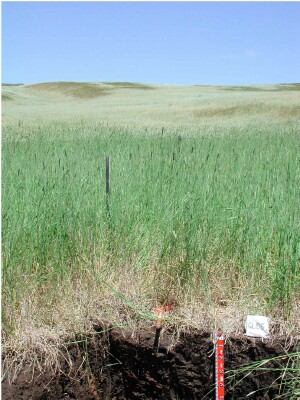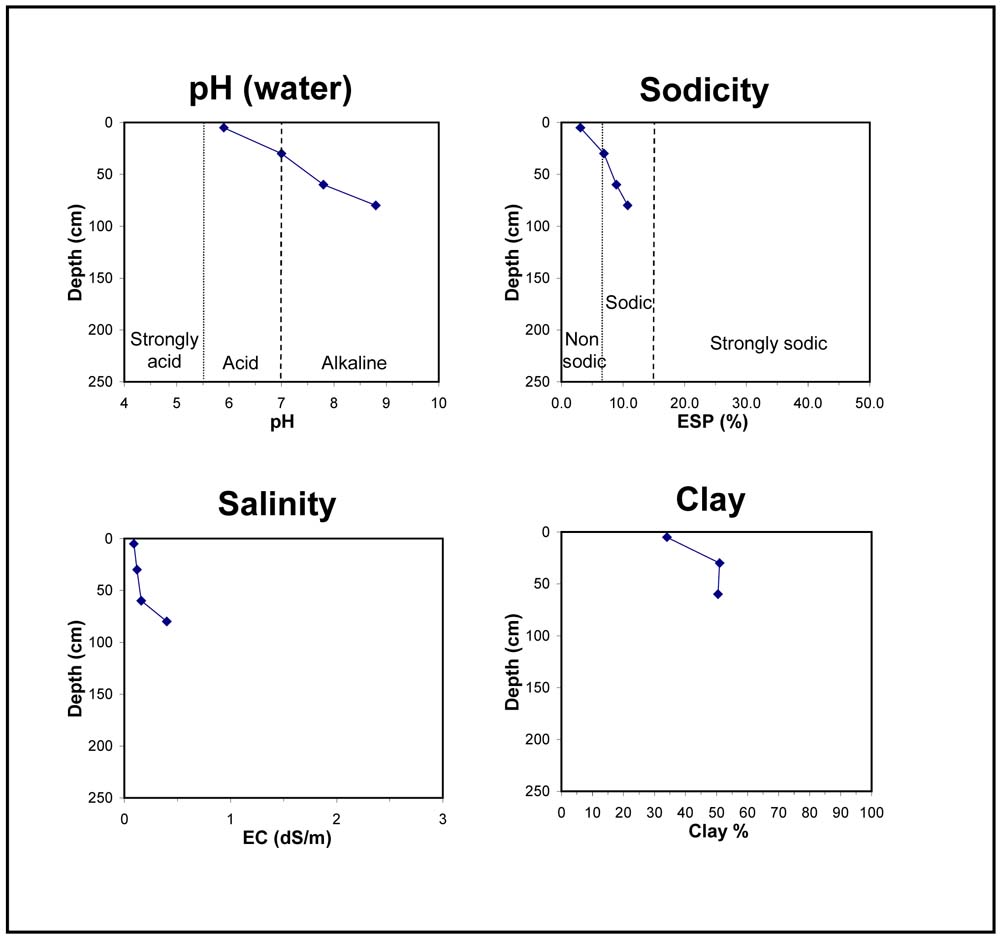GL156
| Site: GL156 | Land Unit: Dundas Trachyte |
| Aust. Soil Class.: Vertic, Mottled-Subnatric, Black SODOSOL (confidence level 1) | |
 | General Land Unit Description: There are a few isolated outcrops of Jurassic trachyte in the north-western portion of the study area, with the largest outcrop being north east of Coleraine. There are also some colluvial slopes on the edge of trachyte outcrops around the Dundas and Merino Tablelands. The trachyte hills often have rock outcrop and reasonably shallow soils on the crests and upper slopes. The main soil type on the upper slopes is a Brown Sodosol although Chromosols also occur and they are commonly sodic at depth. The soils on the colluvial slopes tend to be black cracking clays (Vertosols) or Black Vertic Sodosols. These soils are similar to the black soils of the dissected Merino Tablelands land unit. The soils on these slopes are a complex mix of different soil forming processes. This site occurs on the Tablelands. It has basaltic soils developed on a colluvial fan below a minor drainage depression coming off the Tablelands. The surface is self-mulching and black clay veins moving down the profile gives an indication of the cracking nature of the soil. The cracking stops above the BC horizon. Gilgai microrelief is evident. As a result of the clay subsoil, the internal drainage is imperfectly drained. |
Site Description:
| Slope: 14% | Geology: Jurassic trachyte |
| Landform pattern: Rolling low hills | Position in landscape: Mid to lower slope |
| Internal drainage: Imperfectly drained |
| A1 | 0-10 cm | Very dark greyish brown (10YR3/2) clay loam, strong subangular blocky structure (2-5 mm), weak consistence when moist, pH 5.9; clear transition to: |  |
| Subsoil | |||
| B21 | 10-50 cm | Black (2.5Y2.5/1) medium heavy clay, distinct coarse light olive brown mottles (2.5Y5/4), strong lenticular structure (20-50 mm) to medium polyhedral structure (10-20 mm), strong consistence when dry and very plastic when wet, very few small basalt fragments (2-6 mm), pH 7.0; gradual transition to: | |
| B22 | 50-70 cm | Very dark greyish brown (2.5Y3/2) heavy clay, many distinct coarse light olive brown mottles (2.5Y5/4), strong lenticular structure (20-100 mm) to a strong polyhedral structure (5-20 mm), strong consistence when dry, very few small basalt fragments (2-6 mm), black organic veins evident, pH 7.8; clear wavy transition to: | |
| B23 | 70-90 cm | Dark yellowish brown (10YR4/4) heavy clay, many faint fine red mottles, strong lenticular structure (10-50 mm) to a strong polyhedral structure (10-20 mm), strong consistence when dry, very few fine manganiferous and very few fine calcareous segregations, black organic veins evident, cracking stops at bottom of horizon pH 8.8; diffuse transition to: | |
| C | 90-150+ cm | Dark yellowish brown (10YR4/4), medium (2-6 mm) calcareous segregations are common, few medium (6-20 mm) subangular basalt fragments. |
Key profile features:
- Sodic subsoil
- Alkaline deeper subsoil
- Subsoil cracks at depth
- Calcium carbonate at depth
- Topsoil dispersive when worked when wet
- Subsoil dispersive when worked when wet



